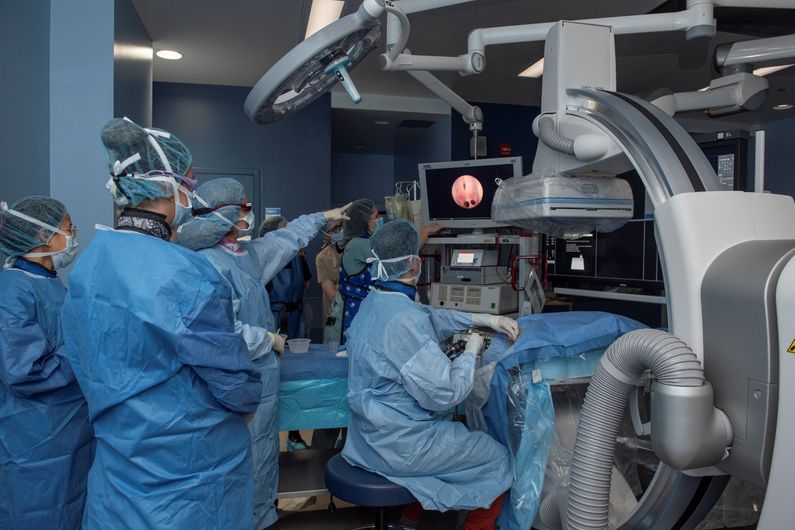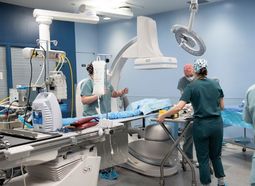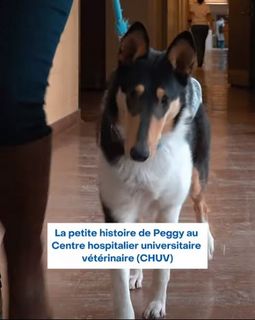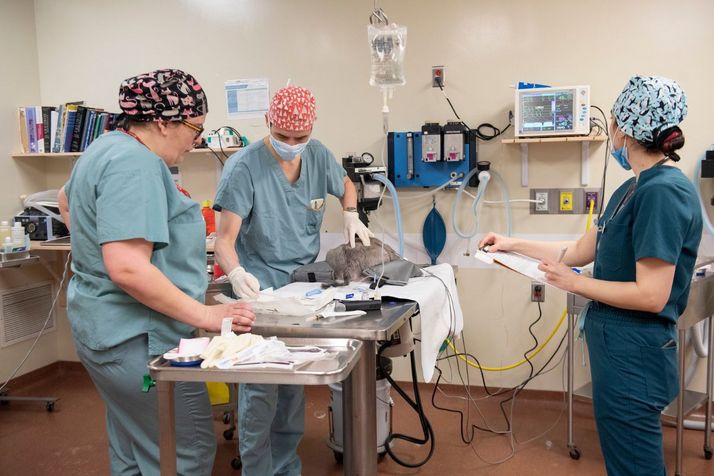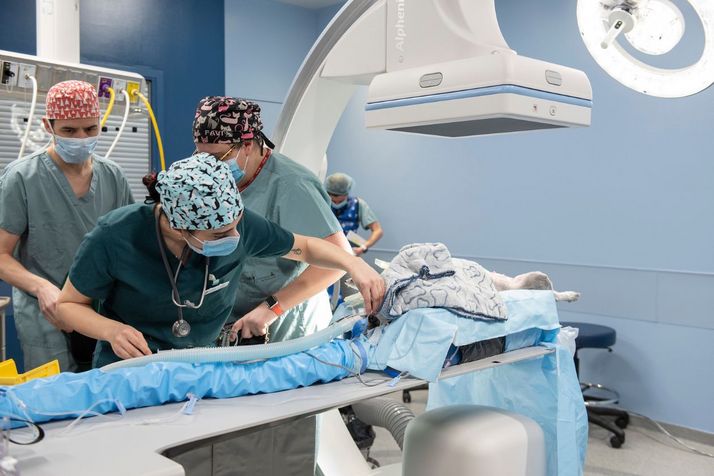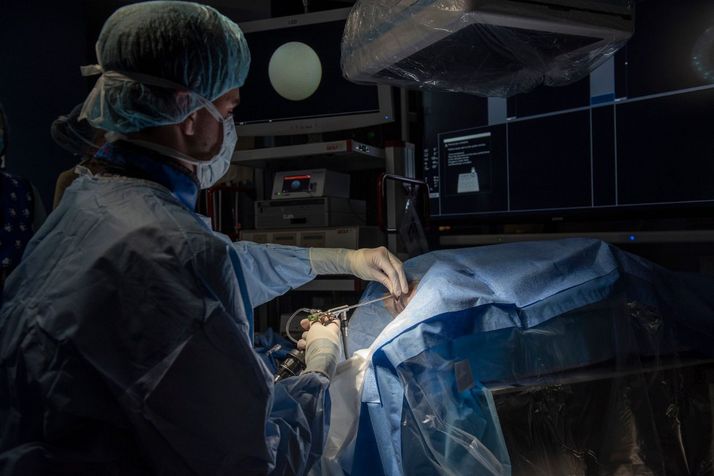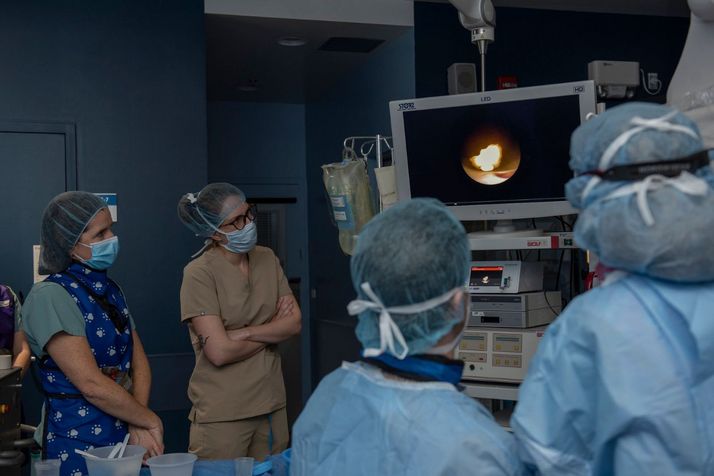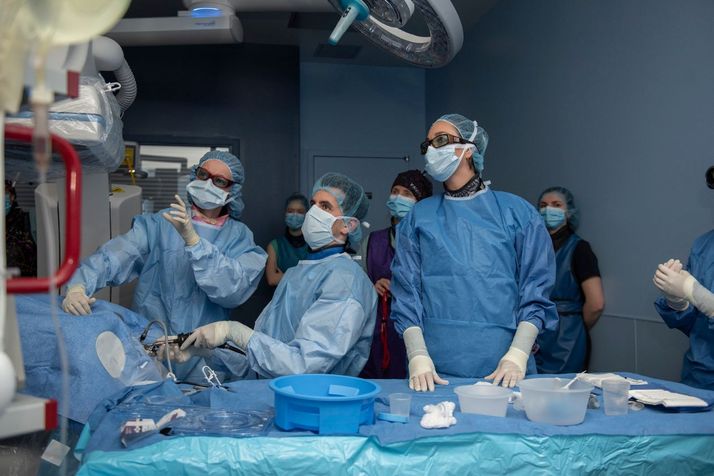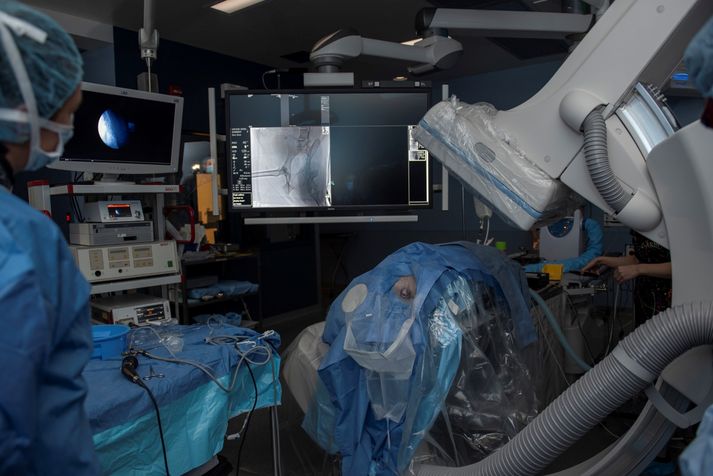New veterinary centre of excellence is the only one of its kind in Canada
- UdeMNouvelles
03/12/2024
- Martin LaSalle
As the story of Stella the schnauzer illustrates, UdeM's new Centre of Excellence in Interventional Medicine is well-equipped for specialized, minimally invasive procedures.
A year ago, Stella, a 6 1/2-year-old miniature schnauzer, underwent surgery at a veterinary clinic to remove bladder stones. A few days later, recuperating at home, she jumped off a couch and her wound reopened. The result was pain, bleeding and another trip to the vet.
Eventually, more stones formed in the Stella's bladder, but the dog's owners didn’t want to put her through the same operation again. That's when their vet told them about a new, minimally invasive procedure at the Centre hospitalier universitaire vétérinaire (CHUV) in Saint-Hyacinthe.
Last February 22, Stella came under the care of Dr. Marilyn Dunn, the driving force behind the CHUV's new Centre of Excellence in Interventional Medicine, known by its French acronym CEMI. Dunn is also a founding member of the American College of Veterinary Nephrology and Urology and of the Veterinary Interventional Radiology & Interventional Endoscopy Society.
A $1-million donation from pet food company Royal Canin Canada and a $200,000 donation from the Boehringer Ingelheim pharmaceutical company made it possible to buy the medical equipment for CEMI. The gifts were made as part of the university's recently launched L'heure est brave fundraising campaign.
Ongoing care and training
CEMI is equipped with state-of-the-art technology including endoscopy, angiography and fluoroscopy, making it the only centre of its kind in Canada. In the U.S., there are only three such facilities.
At CEMI, Dunn and her colleague Catherine Vachon perform a range of diagnostic and therapeutic procedures for the respiratory, cardiovascular and urinary systems of pets, wildlife, zoo animals and farm animals. Their minimally invasive approach makes it possible to treat more patients.
With its fluoroscopy table, system of screens, integrated anesthesia system and other equipment, CEMI is also used to train veterinary students as well as "veterinarians from around the world who want to specialize in or familiarize themselves with these types of procedures," said Dunn.
Less invasive
Thanks to the devices and equipment acquired with the donations, the veterinarians are able to perform minimally invasive procedures and watch their manoeuvres on the screen in real time. This is how resident Corentin Treich performed the procedure on Bella, under Dunn’s supervision.
"The image-guided procedure involved inserting an endoscope through the animal's urinary tract to the bladder in order to locate the stones and fragment them with a laser," explained Dunn. “That makes it easier to remove the stones through the natural pathway, without having to make an incision."
To make sure all the stones were gone, a C-shaped X-ray machine rotated around Bella while she lay on the fluoroscopy table, sending a video of her insides to another screen.
Unlike Stella’s first operation and subsequent recovery, which was trying for her and her owners, the CEMI procedure left no trace.
"Typically, surgery to remove bladder stones requires a 14-day convalescence with painkillers and a cone to keep the dog from biting the wound," said Dunn. “With the endoscopic procedure, there is no wound. In Bella's case, she was discharged from the hospital the same day and could have gone to the dog park that evening."
Centre meets a need
An UdeM professor since 2002 and specialist in internal medicine for companion animals, Dunn was interested in interventional medicine even before it was practiced at the Faculty of Veterinary Medicine.
"We had a patient with a collapsed trachea that wasn't responding to treatment, so we asked doctors we knew for expired stents they'd used to clear the bronchial tubes in babies," she related. “We tried this on our patient and it worked!"
It was the first tracheal stenting performed on an animal in Canada.
That case spurred Dunn to go further and specialize in image-guided diagnostic procedures for animals, a relatively new field at the time. In 2008, she was awarded a fellowship at the University of Pennsylvania under the direction of Dr. Chick Weisse and Allyson Berent.
On her return, Dunn set up the Interventional Medicine Department at the CHUV’s pet hospital.
"With time, we found that our equipment limited for what we could do,” she recalled. “So in 2016, we came up with the idea of creating an interventional medicine centre of excellence. We drew up a budget and reached out to clients and businesses to raise the funds."
The rest is history. But CEMI owes its existence, first and foremost, to the needs expressed by pet owners, Dunn said.
"Our clients are our best ambassadors. They’re the ones who ask us to operate on their pets in the least invasive way possible. Interventional medicine helps improve our patients' comfort while reducing their recovery time."
To watch the video in which Peggy, another dog suffering from bladder stones, underwent the same procedure at CEMI, click here.


